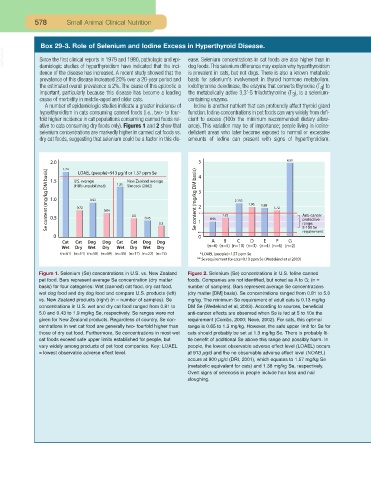Page 559 - Small Animal Clinical Nutrition 5th Edition
P. 559
578 Small Animal Clinical Nutrition
Box 29-3. Role of Selenium and Iodine Excess in Hyperthyroid Disease.
VetBooks.ir Since the first clinical reports in 1979 and 1980, pathologic and epi- ease. Selenium concentrations in cat foods are also higher than in
demiologic studies of hyperthyroidism have indicated that the inci-
dence of the disease has increased. A recent study showed that the dog foods.This selenium difference may explain why hyperthyroidism
is prevalent in cats, but not dogs. There is also a known metabolic
prevalence of this disease increased 20% over a 20-year period and basis for selenium’s involvement in thyroid hormone metabolism.
the estimated overall prevalence is 2%.The cause of this epizootic is Iodothyronine deiodinase, the enzyme that converts thyroxine (T ) to
4
important, particularly because this disease has become a leading the metabolically active 3,3’-5 triiodothyronine (T ), is a selenium-
3
cause of morbidity in middle-aged and older cats. containing enzyme.
A number of epidemiologic studies indicate a greater incidence of Iodine is another nutrient that can profoundly affect thyroid gland
hyperthyroidism in cats consuming canned foods (i.e., two- to four- function.Iodine concentrations in pet foods can vary widely from defi-
fold higher incidence in cat populations consuming canned foods rel- cient to excess (100x the minimum recommended dietary allow-
ative to cats consuming dry foods only). Figures 1 and 2 show that ance). This variation may be of importance; people living in iodine-
selenium concentrations are markedly higher in canned cat foods vs. deficient areas who later become exposed to normal or excessive
dry cat foods, suggesting that selenium could be a factor in this dis- amounts of iodine can present with signs of hyperthyroidism.
Figure 1. Selenium (Se) concentrations in U.S. vs. New Zealand Figure 2. Selenium (Se) concentrations in U.S. feline canned
pet food. Bars represent average Se concentration (dry matter foods. Companies are not identified, but noted as A to G; (n =
basis) for four categories: Wet (canned) cat food, dry cat food, number of samples). Bars represent average Se concentrations
wet dog food and dry dog food and compare U.S. products (left) (dry matter [DM] basis). Se concentrations ranged from 0.81 to 5.0
vs. New Zealand products (right) (n = number of samples). Se mg/kg. The minimum Se requirement of adult cats is 0.13 mg/kg
concentrations in U.S. wet and dry cat food ranged from 0.81 to DM Se (Wedekind et al, 2003). According to sources, beneficial
5.0 and 0.43 to 1.9 mg/kg Se, respectively. Se ranges were not anti-cancer effects are observed when Se is fed at 5 to 10x the
given for New Zealand products. Regardless of country, Se con- requirement (Combs, 2000; Neve, 2002). For cats, this optimal
centrations in wet cat food are generally two- fourfold higher than range is 0.65 to 1.3 mg/kg. However, the safe upper limit for Se for
those of dry cat food. Furthermore, Se concentrations in most wet cats should probably be set at 1.3 mg/kg Se. There is probably lit-
cat foods exceed safe upper limits established for people, but tle benefit of additional Se above this range and possibly harm. In
vary widely among products of pet food companies. Key: LOAEL people, the lowest observable adverse effect level (LOAEL) occurs
= lowest observable adverse effect level. at 913 µg/d and the no observable adverse effect level (NOAEL)
occurs at 800 µg/d (DRI, 2001), which equates to 1.57 mg/kg Se
(metabolic equivalent for cats) and 1.38 mg/kg Se, respectively.
Overt signs of selenosis in people include hair loss and nail
sloughing.

